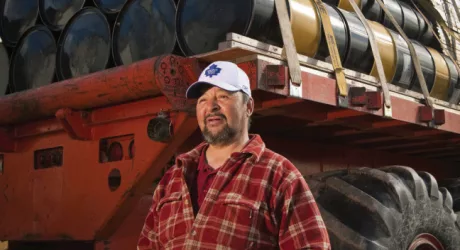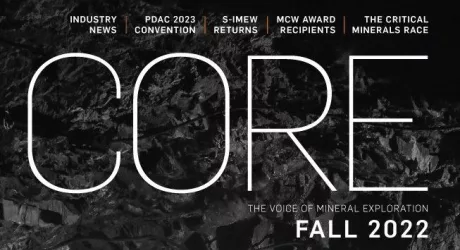

Social Impact Report
Projects on Indigenous Communities
In the spring of 2022, the Prospectors & Developers Association of Canada (PDAC) completed its study on the Social Impact of Mineral Development Projects in Indigenous Communities (the Study). The aim was to identify the anticipated impacts, and subsequent increased demands, on social infrastructure for host Indigenous communities within proximity to mineral development projects in Canada.
Using a gendered lens, the Study established a set of practical strategies for mineral resource development companies to exercise as a way to improve the situations often found in remote Indigenous communities, and use them to mitigate or manage the social impacts on host communities.
This project was inspired by recommendations made to the extractive sector in the final report of the National Inquiry into Missing Murdered Indigenous Women and Girls calling upon government and industry to recognize that, “social infrastructure must be expanded and service capacity built to meet the anticipated needs of the host communities in advance of the start of projects”. The research also aligns with the federal government’s commitments to implement the Truth and Reconciliation Commission’s Calls to Action and accelerate the United Nations Declaration on the Rights of Indigenous Peoples National Action Plan.
Research Seeks to Answer the Following Questions:
- What changes to the social and cultural fabrics may occur in Indigenous communities during the development of a mineral project?
- How do these changes impact the social and cultural well-being of a community?
- What social infrastructures are missing or under-resourced to mitigate these strains?
- Which form of social infrastructure should be expanded and what service capacities should be built to meet the anticipated needs of host communities in advance of projects?
Methodology and Scope
The Social Impact Study was a multi-phase project that included:
- PHASE 1: A literature review of previously published reports and information related to Indigenous identity in Canada, an historical overview of colonization and associated traumas, government relationships, resource developments, community impacts, well-being and more.
- PHASE 2: A case study was at the high-grade underground Brucejack Gold Mine in northwestern British Columbia, on the traditional territory of the Skii km Lax Ha First Nation and the Tahltan First Nation.
- PHASE 3: Interviews were conducted with several Indigenous community members, seeking to uncover unique perspectives and experiences.
- PHASE 4: A full analysis period of all information gathered from the previous three phases, followed by the development of a series of recommendations for how mineral resource companies can design and execute projects that integrate principles of sustainability to mitigate social impacts on Indigenous host communities, as well as how to design mutually respectful, appropriate, and effective Indigenous partnerships and programs.
Recommendations for Mineral Development Companies
Stakeholder Engagement
| Recommended Action | Benefits |
|---|---|
| Direct outreach to women specifically, women-only focus groups and interviews. | A gender-specific engagement process will help the company obtain information from a unique point of view. Listening to Indigenous women voices will help design and execute community relations and development programs that are culturally appropriate and would benefit the community as a whole. Further making community programs more successful and sustainable, thereby protecting the company’s investment, and strengthening the company’s reputation and place as a preferred corporate citizen. |
| Early and consistent engagement with elderly population, including tailored programs, supports, and resources for elders. | Elders play a significant role in Indigenous culture, tradition, and communities. Elders represent a generation of individuals that are not specifically sought out for employment but uniquely experience social impacts of mineral resource projects. To support the livelihood and significant role of elders is a form of supporting the resilience and longevity of an Indigenous community. When the company views elders as a key stakeholder group with high influence in the community and engage or consult with them accordingly, they have a better chance of building credibility with the larger community. |
Social Impact & Opportunities Assessments
| Recommended Action | Benefits |
|---|---|
| Integrate gender considerations. | Modify the typical assessment practice using a gender lens to assess the impacts on women and on the relationship between the men and women of the communities, the division of labour between men and women within the community and the household. |
| Comprehensive assessment of the socioeconomic situation. | Companies are willing to commit resources to bring benefits to the host communities, support their economic development and improve the lifestyle of the locals. However the lack of infrastructure, education opportunities, and recreational options limit the fruition of these initiatives if people prefer to go elsewhere rather than stay in their communities. A comprehensive assessment of these issues could help the mining company in the development of programs that could actually benefit the community and invite people to stay in their lands. |
| Apply a human rights-based approach. | Applying a human rights-based approach to Indigenous women as part of social impact and community development initiatives will ensure that inequalities and marginalization's are being addressed for that demographic. This approach will empower Indigenous women to participate in decision-making processes as vulnerable community members while also holding company’s accountable. |
Local Expertise
| Recommended Action | Benefits |
|---|---|
| Seek out expert local Indigenous representation, with a special consideration for elders who are women. | This would ensure a gendered and generational perspective of community structural values and needs to be heard and addressed in terms of support provision. When hiring experts from the local Indigenous community, particularly women, programs will be designed with the broader community in mind, not just the local male employees. This makes any community or employment program more effective. |
Human Resources Practices
| Recommended Action | Benefits |
|---|---|
| Implement a hiring practice that educates potential employees and their families on the work-life adjustment that comes with rotational employment. | This is a proactive support that could prevent and/or reduce the amount of distress that may follow with a family’s dynamic adjustment due to a member being employed by a mining company. Equipping the potential employee with information on the work-life adjustment and tools on how to manage the new dynamic could smoothen the transition and mitigate home distress that would result from unfamiliarity and unpreparedness with the new work-life balance. |
| Provide sufficient and appropriate accommodation for employees and contractors arriving to the project. | Lack of housing is prevalent in remote Indigenous communities and the arrival of a mineral resource development project will likely aggravate it. Provisions should be taken to have sufficient accommodation for its employees and contractors, and when this is not possible, adequate engagement should happen with the host community in order to find necessary accommodations without disrupting the community’s traditional lifestyle. |
Program Design
| Recommended Action | Benefits |
|---|---|
| Include families and communities of employees in the provision of learning materials, tools, and resources as educational aids for the promotion and encouragement of mental health management. | The change in lifestyle and impact to culture that a mineral resource development project can put on a remote Indigenous community can significantly impact family and community relationships, and mental health of the population. Advocating and promoting for tools and practices that support mental health management is a form of resilience building, as these mechanisms will advance the community for the long-term. Mental health supports do not need to be provided only in the event of illness or incidents. To proactively work towards community building is ensuring local employees and community members understand mental health challenges beforehand and are given the resources and tools to maintain healthy livelihoods via relationships, income, self-care, traditional care, etc. |
| Provide financial literacy courses to introduce community members to concepts and management tools for financial health, prior to, during and following the presence of a mineral resource development project. | This will ensure that community members are familiar with financial management concepts so that when an adjustment in income occurs, they have the financial literacy to manage it. Providing this form of support will enhance the socioeconomic health of a community overall, and improve livelihoods. |
| Assess the food security situation in the host communities where the mineral resource project is planning to develop and operate. | Mining companies have a variety of resources that can help alleviate the struggles a community may have related to food security. If the company understands the prevalent situation of food security in the area, this will allow them to explore partnerships that can support the community to overcome this challenge and fulfill its duty to share value. |
| Education on life skills. | Providing resources and education on work-life balance that is necessary for employment in the mineral resource industry could proactively mitigate the potential for home distress. This kind of support should be given not only to the potential employee but also to their family as the social impacts of employment will directly and indirectly affect the family members. |
Future Opportunities
Additional Resources
- Government of Canada - Exploration and Mining Guide for Aboriginal Communities (2013)
- Indigenous Services Canada - Report on trends in First Nations communities, 1981 to 2016 (2019)
- International Council on Mining and Metals - Indigenous Peoples and Mining - Good Practice Guide (2015)
- National Inquiry into Missing and Murdered Indigenous Women and Girls (Canada) - Reclaiming Power and Place: The Final Report of the National Inquiry into Missing and Murdered Indigenous Women and Girls (2019)
- Pauktuutit Inuit Women of Canada - Addressing Inuit Women’s Economic Security and Prosperity in the Resource Extraction Industry (2021)
- The Land Claims Agreements Coalition - Honour, Spirit, and Intent: A Model Canadian Policy on the Full Implementation of Modern Treaties Between Aboriginal Peoples and the Crown (2008)
- Truth and Reconciliation Commission of Canada - Canada’s Residential Schools: The final report of the Truth and Reconciliation Commission of Canada (2015)


